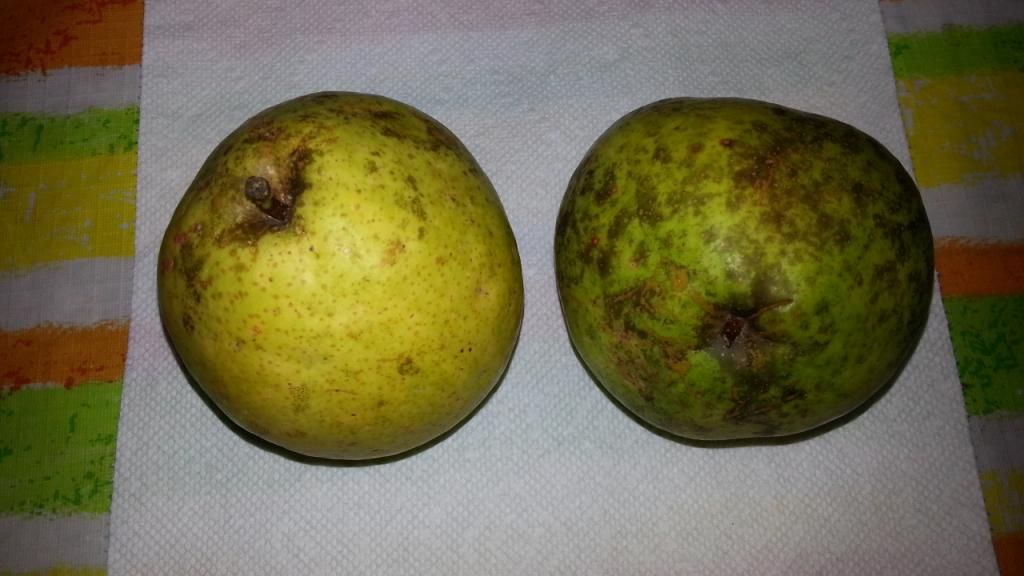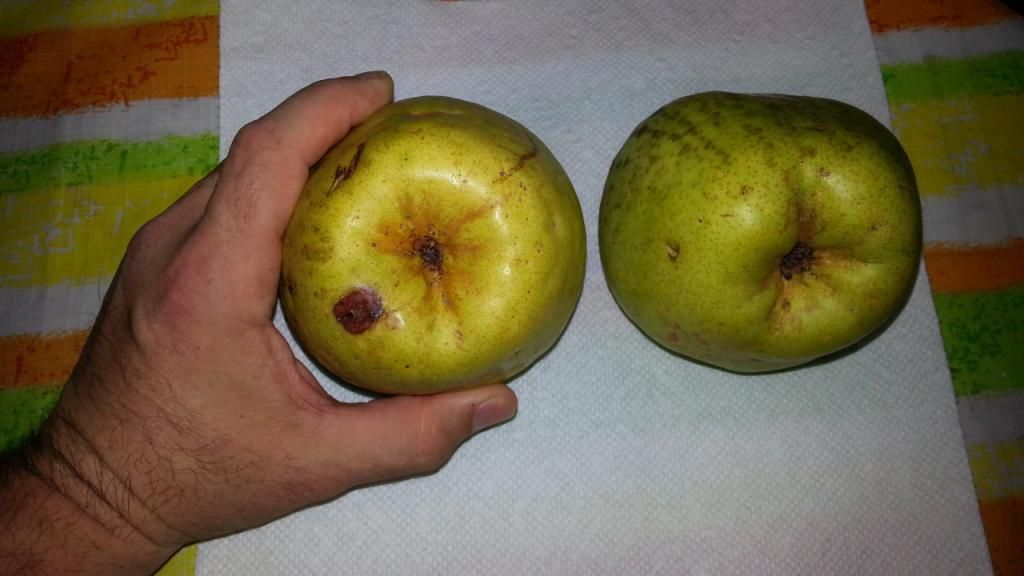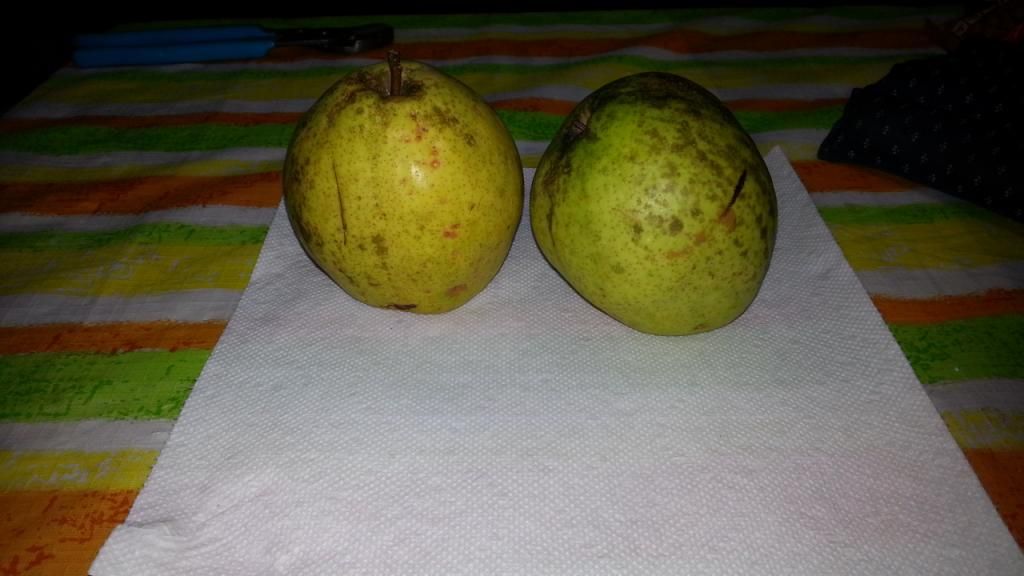|
|
Post by Drahkk on Sept 22, 2014 22:00:57 GMT -5
I have a question for those more experienced in fruit tree propagation than myself. Mom in law brought me a couple of odd looking pomme fruits today with a story. Here are the fruits: Stem view:  Bloom end view:  Side view:  They're not much to look at, but quite tasty. Here is the story, as it was given to me: The tree belongs to my sister in law's father's neighbor. He (her father) has been eating them for years, and loves them. The tree is some type of pear grafted to an apple rootstock 70 years ago by a county agent. At this point noone knows what the original varieties were. All we know us that the fruit are quite large and tasty and have a shape and flavor somewhere between apple and pear, and the tree is hardy and resistant to local pests. They seem quite convinced that the two have merged somehow. So here is my question. If this really is the result of a graft chimera, it would certainly not come true from seed. Do you think it could be propagated via a new graft, or a rooted cutting? Mom in law wants a tree, and I wouldn't mind one myself... |
|
|
|
Post by steev on Sept 22, 2014 22:08:57 GMT -5
Should be graftable; less easily rootable, but would grow true either way. Don't know about "graft chimera", but whatever; if it's good, propagate it.
|
|
|
|
Post by copse on Sept 22, 2014 22:48:39 GMT -5
Be interesting to hear whether it works. This was the part of the Lysenko thread I wanted to learn more about, but never got around to. |
|
|
|
Post by Joseph Lofthouse on Sept 22, 2014 23:19:41 GMT -5
A graft chimera would produce apples on some twigs and pears on different twigs.
I'm of the opinion that genetically the fruit is a pear fruit and will produce pear seedlings. The seedlings will likely be genetically diverse and very unlikely to come true to type, but since children tend to resemble their parents chances are good that they will be somewhat close. According to the story the fruits on the current tree are nurtured by apple-sap so some of the chemicals in the fruit are likely to be apple chemicals which may change the flavor or form slightly. Grafting a scion of the pear onto a different (apple or pear) rootstock might give somewhat different results.
Extremely unlikely is that two of the cells merged to create an inter-species hybrid, and that the pear scion died off and only the hybrid remains growing on the apple roots.
|
|
|
|
Post by steev on Sept 23, 2014 1:42:25 GMT -5
I agree, but repeat that if it's good, propagate it.
|
|
|
|
Post by copse on Sept 23, 2014 4:57:12 GMT -5
Grafting a scion of the pear onto a different (apple or pear) rootstock might give somewhat different results. Looking further at that Michurin thread, for leads on what sort of results might apply, I've been reading articles on bulbnrose.x10.mx. It's not exactly scientific, but.. anyway.. The effect of obtain an apple-shaped pear of sorts, was consistently reproducible by one writer. For a straight graft and maintaining the properties, it may come down to what it is grafted to, and be worthwhile grafting to a selection of varieties. I think I've personally grafted my local very red apple scions to a granny smith just a week or so ago, and this may have been mistake as I wanted to preserve the colour. Perhaps it might be possible to refine the scion by "grafting in and in" on the existing tree to lock in the desired properties, before trying to graft it off onto the target trees. |
|
|
|
Post by copse on Sept 24, 2014 3:51:37 GMT -5
Been going over a variety of more modern graft hybridisation papers. Regarding the seed propagation, this is the closest paper to showing likelihood of even partial success I've found.
|
|
|
|
Post by Drahkk on Sept 25, 2014 19:54:39 GMT -5
Thanks for all the responses! Joseph and Steev, that was how I thought graft chimeras worked: that they would produce one or the other on different twigs, rather than a hybrid. But I think I must have read one or more of the papers Copse is referencing as well, as it was that possibility of a graft hybrid that struck me when I saw this fruit. They really do look like pears on top and apples on bottom. Unfortunately I'm not in a position to grow out a hundred trees in hope of a hybrid seed or two. Actually I don't even have proper rootstock to graft to; if it were a peach or plum no problem, but a pomme I don't have to spare. I think I may get some scions this winter and try grafting a few to the mature apple in my yard just to grow them out, and treat a few more with rootone after scraping to expose cambium. If the grafts take I can try air layering later.
|
|
|
|
Post by copse on Sept 26, 2014 15:13:40 GMT -5
Finding this subject quite interesting, I've been trying to ask questions about it, and whether there is any more research relating to this. Unfortunately, the notion that graft hybridisation may make any difference, is something akin to discussion of conspiracy theory :-) It results in responses asserting that only disease resistance and tree size can be affected, and vague anecdotes about how they've never seen anything other than minor differences and statements like not believing everything I read. Listing the peach to almond to peach grafting example, a misinterpretation was made by a respondent and based on this, it was used to dismiss the question with a comment starting with "I had to laugh.." betraying a bias against even looking at it objectively. I'd like to know for instance given that genetic material has been shown to transfer past the graft, whether rootstock grafting would be scientifically more likely to produce hybrid effects, or top grafting. Again unfortunately I've been unable to elicit useful modern research, and while I would assume a the rootstock grafting would be better, the old 1886 letter implies otherwise. |
|
|
|
Post by Joseph Lofthouse on Sept 26, 2014 21:06:40 GMT -5
We don't generally see the creation of tetraploid-hybrids when we graft apple scions onto apple root stocks. I wouldn't expect it to happen with apple/pear grafts. Sure there are some variations in phenotypes depending on which root-stock is used, but the fruit remains basically the same.
|
|